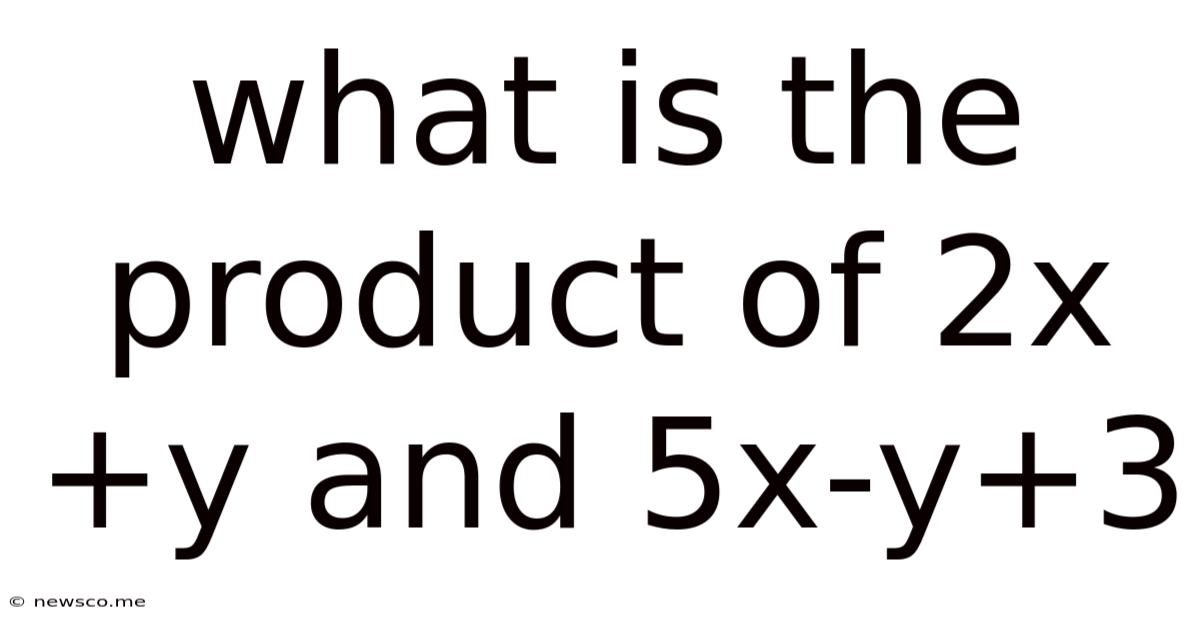What Is The Product Of 2x+y And 5x-y+3
News Co
Mar 15, 2025 · 4 min read

Table of Contents
What is the Product of (2x + y) and (5x - y + 3)? A Comprehensive Guide to Polynomial Multiplication
This article delves into the process of multiplying two binomials, specifically (2x + y) and (5x - y + 3). We'll explore the fundamental principles of polynomial multiplication, provide a step-by-step solution, and discuss various applications and related concepts. This in-depth analysis aims to solidify your understanding of algebraic manipulation and improve your problem-solving skills.
Understanding Polynomial Multiplication
Before we tackle the specific problem, let's review the core concepts behind multiplying polynomials. A polynomial is an expression consisting of variables and coefficients, involving only the operations of addition, subtraction, multiplication, and non-negative integer exponents. Multiplying polynomials involves applying the distributive property (often called the FOIL method for binomials) repeatedly.
The distributive property states that for any expressions a, b, and c:
a(b + c) = ab + ac
This simple rule is the foundation of all polynomial multiplication. When multiplying binomials, we essentially apply this property twice.
The FOIL Method (for Binomials)
When multiplying two binomials, the FOIL method provides a helpful mnemonic:
- First: Multiply the first terms of each binomial.
- Outer: Multiply the outer terms of each binomial.
- Inner: Multiply the inner terms of each binomial.
- Last: Multiply the last terms of each binomial.
Then, combine like terms to simplify the resulting expression.
Multiplying (2x + y) and (5x - y + 3)
Now, let's apply these principles to find the product of (2x + y) and (5x - y + 3). Because (5x - y + 3) is a trinomial (three terms), we can't directly use the FOIL method. Instead, we'll extend the distributive property to handle the multiplication.
We can think of this as:
(2x + y)(5x - y + 3) = 2x(5x - y + 3) + y(5x - y + 3)
Let's break it down step-by-step:
1. Distribute 2x:
2x(5x - y + 3) = (2x)(5x) + (2x)(-y) + (2x)(3) = 10x² - 2xy + 6x
2. Distribute y:
y(5x - y + 3) = (y)(5x) + (y)(-y) + (y)(3) = 5xy - y² + 3y
3. Combine the results:
Now, add the results from steps 1 and 2:
10x² - 2xy + 6x + 5xy - y² + 3y
4. Combine like terms:
Notice that we have two terms with 'xy': -2xy and 5xy. Combining these gives us 3xy. Therefore, the simplified expression is:
10x² + 3xy - y² + 6x + 3y
This is the final product of (2x + y) and (5x - y + 3).
Understanding the Result: A Deeper Look
The resulting polynomial, 10x² + 3xy - y² + 6x + 3y, is a polynomial of degree 2. The degree of a polynomial is the highest power of the variable present in the expression. In this case, the highest power is 2 (from the 10x² term). This polynomial is also a quadratic polynomial in two variables (x and y).
The terms in the polynomial represent different combinations of the variables resulting from the multiplication. For example, the 10x² term comes from multiplying the '2x' and '5x' terms. The 3xy term is the result of combining the '2x(-y)' and 'y(5x)' terms after simplification. Each term's coefficient and the variables it contains reflect the original binomial multiplication process.
Applications and Extensions
Polynomial multiplication is a fundamental concept in various areas of mathematics and science. Here are some key applications:
- Algebra: Solving equations, simplifying expressions, and factoring polynomials.
- Calculus: Finding derivatives and integrals of polynomial functions.
- Geometry: Calculating areas and volumes of geometric shapes.
- Physics: Modeling physical phenomena and solving equations related to motion, forces, and energy.
- Computer Science: Implementing algorithms and solving computational problems.
Expanding to More Complex Polynomials
The method we used to multiply (2x + y) and (5x - y + 3) can be extended to multiply polynomials with more terms. The key is to systematically distribute each term of one polynomial across all terms of the other polynomial and then simplify the resulting expression by combining like terms.
Factoring Polynomials – The Reverse Process
Factoring is the reverse process of polynomial multiplication. Given a polynomial, factoring involves finding the expressions that, when multiplied, result in the original polynomial. This skill is essential for solving equations and simplifying expressions. The polynomial 10x² + 3xy - y² + 6x + 3y is generally difficult to factor back into (2x+y)(5x-y+3) directly, highlighting the complexity of factoring compared to multiplying.
Practice Problems
To reinforce your understanding, try these practice problems:
- Multiply (3x - 2) and (x² + 4x - 1).
- Find the product of (x + y + z) and (2x - y).
- Expand (a + b)² and (a - b)². (Hint: Remember the difference of squares).
- Multiply (x + 2)(x - 2)(x + 3).
Working through these problems will help you gain proficiency in polynomial multiplication.
Conclusion: Mastering Polynomial Multiplication
Understanding polynomial multiplication is crucial for success in algebra and beyond. By mastering the distributive property and systematically applying it, you can confidently tackle complex polynomial multiplications. Remember to always simplify your results by combining like terms to arrive at the most concise and elegant representation of the product. The more you practice, the more intuitive this process will become, leading to greater efficiency and accuracy in your mathematical work. The techniques discussed here – including the extension of the distributive property beyond the FOIL method – provide a solid foundation for tackling even more challenging polynomial manipulations in future studies.
Latest Posts
Related Post
Thank you for visiting our website which covers about What Is The Product Of 2x+y And 5x-y+3 . We hope the information provided has been useful to you. Feel free to contact us if you have any questions or need further assistance. See you next time and don't miss to bookmark.